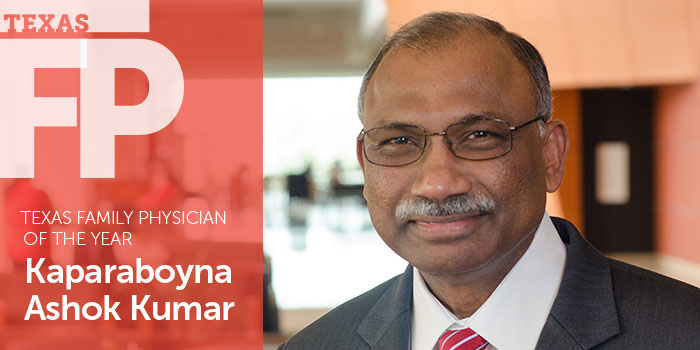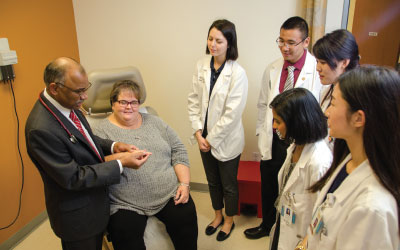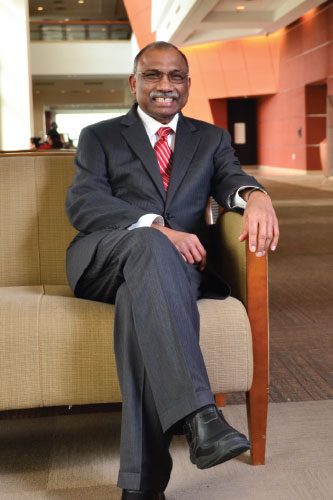The servant leader

The servant leader
Story by Kate Alfano and photos by Jonathan Nelson
Any family physician who has trained or practiced in Texas over the past two decades has most likely been positively affected — directly or indirectly — by Kaparaboyna Ashok Kumar, MD, FRCS, FAAFP, the 2016 TAFP Family Physician of the Year, through his service to medical education, patient care and community, and organized medicine.
As a distinguished teaching professor of family and community medicine at the University of Texas Health Science Center at San Antonio and vice-chair of medical education and clerkship director for their Department of Family Medicine, Kumar teaches 220 medical students and 39 residents each year. He also sees patients in clinic, and has served on countless committees and in leadership positions for the Bexar County Medical Society, Texas Academy of Family Physicians, American Academy of Family Physicians, Texas Medical Association, and Society of Teachers of Family Medicine.
But it isn’t his extensive resume that makes this physician shine; it is his servant heart, his gentle manner, his extensive medical knowledge, and his ready willingness to share his time with others.
Kumar grew up in Narsampet, a small town of roughly 10,000 people in the southern Indian state of Telangana. His father left his job as a manager for a textile mill to become a “freedom fighter,” a community leader who, among other things, brought medical services to the town in the years after India’s independence from British rule. Along with his mother, sister and four brothers, Kumar witnessed his father’s selfless service firsthand and it made a deep impression. “I learned the joys of community service from my father, starting in my childhood,” Kumar says.
Kumar’s father was well educated and spoke English and Urdu, the local official language. The townsfolk would come to him to write letters for them or memos for an appeal. Their home served as the hub for community programs like BCG and cholera mass immunizations, and Kumar’s father advocated for public programs to provide a safe water supply and electricity for their town.
“This community service inspired me,” Kumar says. “It came naturally for me to help people. At 7 or 8 years old I thought, ‘I need to be a physician, I want to help people,’ and then I worked toward it.”
Kumar received his education through the high school level in Narsampet, where classes and textbooks were in his mother tongue of Telugu, then he prepared for the Medical College Entrance Test in English. He competed with upwards of 10,000 applicants for 150 medical school spots for the whole state of Telangana. As a small-town boy he was at a disadvantage as many students from bigger cities were educated at English-medium schools and were more fluent in the language — but he received top marks on the test and was the only student from his class to be admitted to medical school.
The school, Osmania Medical College Institute of Medical Sciences, is located in Hyderabad, the capital of Telangana and a huge city with a current-day population roughly five times larger than San Antonio and three times that of Houston. Though only 120 miles from Kumar’s hometown, the journey at that time required many hours of travel over three buses. He spent six years there: one year of advanced sciences and five years of medical coursework.
“What sets him apart is his ability to bring fresh voices into TAFP and AAFP and encourage their growth and development. He never hesitates to encourage a student, resident, or colleague to get more involved with TAFP, to run for a position at the National Conference of Constituency Leaders, or to participate in a committee meeting. He makes our organization stronger with this aspect of his leadership and service.”
– Kathy McCarthy, CAE
TAFP Chief Operating Officer
Though the big city was intimidating, Kumar — a natural “people person” — quickly made friends and excelled in classes. He also continued his tradition of service by coordinating immunization camps in remote areas of the state that could only be traversed most of the way by jeep and the remainder by bicycle. And in his fourth year, he convinced the school’s dean to loan him and his peers the college bus to bring health education to nearby towns that were accessible by road.
Influenced by his professors and the desire to practice medicine and operate, which he knew would enable him to treat more patients, Kumar pursued surgery. And as many of his professors received their higher medical education in England, Kumar sought out and completed a surgical residency at St. James University Hospital in Leeds. After completing the necessary training and passing his examinations, he was elected as a fellow to the Royal College of Surgeons, one of the highest honors. “That’s what most of my professors did so I wanted that, and that’s what I did.”
During his surgical residency he met his wife, Elaine, and they considered where to start their life together after training. Though he considered returning to India to work and teach in a medical school, the couple ultimately decided to explore opportunities in America. As an international medical graduate, Kumar had to go through residency training all over again and was advised by friends to seek out the shortest residency possible to learn the American health care system. One of his American friends in England recommended moving to Tyler, Texas, “because it’s a nice, small town where you can bring up children safely.” The University of Texas Health Science Center at Tyler had one residency program at the time – family medicine – and northeast Texas is where they landed. “The connection to small-town people is in my blood,” Kumar says.
Following his family medicine residency, Kumar and his growing family were recruited to the tiny town of Hugo, Oklahoma, which had no surgeon, to open a private practice for family medicine and surgery. “It didn’t take too long to establish myself as a physician because everyone knows everybody in a small town and word traveled fast.” Patients loved his style of medicine. “What I do is listen to them and give them the time they need. When they get a doctor who talks to them and listens to them, they really cherish it.”
About four years went by and, though he cared deeply for his patients and they for him, Kumar felt a pull to teaching. “I knew I could serve the Hugo population of 5,000 for the rest of my life but to make a bigger impact, I thought I could mentor many students and residents who could carry on my kind of medicine: how we need to care for patients at the bedside, with a trusting relationship, treating them like your family.”
He joined the faculty at his former residency program in Tyler, teaching 20 students a year from UT Southwestern Medical School who rotated through the family medicine clerkship, and training roughly the same number of family medicine residents. After about seven years, though, he looked for a larger program and he found a home at UTHSCSA.

Kumar demonstrates an examination for his medical students with one of this long-time patients, Lisa Villard.
Kumar feels strongly that physician-educators must guide students and residents beyond the science curriculum to also learn about communication, interpersonal relationships, and compassion — the art of healing versus just curing. “We have to be healers in addition to having all the scientific knowledge and technology, which is all very important. I tell my students all the time: The machines attached to a patient are doing all they can but they can never replace a nurse or a doctor. Patient care is only as good as the people looking at those machines, not the machines themselves.”
It’s not just the patients that respond to Kumar’s disposition. Staff wrote in nomination letters that the clinic “buzzes with positive energy and cheerfulness when Dr. Kumar is around” and “he leads by example, showing both patients and colleagues what it means to provide quality care.”
The UTHSCSA patient population is diverse and, in line with the school’s educational mission, the physicians and learners treat complex and underserved patients. But Kumar says there is little difference between small-town and big-city patients: they all just want a physician who will care for them and really pay attention.
“I tell my students, and also it is true in my life, that I have practiced in different cultures and different languages, but it’s that caring attitude and concern that transcends all barriers: barriers of language and culture and nationality and color,” Kumar says. “Different cultures and accents, it doesn’t matter; my patients see that I respect them and want to help them.”
“A lot of my patients don’t shake hands with me, they only hug me – even if I extend my hand,” he says. “My secret is I just want my patient to leave my exam room or my office with a smile on their face. That’s what I work toward because then I know that they’re satisfied. They know how much we care about them and generally they do leave that way.”
Intertwined with all of his years in patient care and teaching are two more elements that support his dedication to medical education, the specialty of family medicine and his patients: leadership in organized medicine and community service.
“Why I get involved [in organized medicine] is we have to work toward better medicine and better patient care,” Kumar says. “All these changes are happening and the only way we can protect the doctor-patient relationship, the only way we can advocate for our patients, is if we take the lead. Not all of the doctors are doing it. I can do some changes in the exam room every day to make my patients feel special, but at the same time there are things we can do as a community of doctors.”
Kumar first became involved in TAFP in 1997 when he attended the Annual Leadership Forum and the National Conference of Constituency Leaders. He was the first international medical graduate delegate to the AAFP Congress of Delegates and the first IMG member of the TAFP Board of Directors. He moved through the ranks as a TAFP officer, ultimately serving as president in 2009-2010. During his presidency, he took on the challenge of increasing medical student interest in family medicine and increasing both student and resident membership in the Academy. He visited every medical school’s Family Medicine Interest Group and every family medicine residency program in the state and challenged all TAFP members to mentor a young student and to encourage them to pursue family medicine.
TAFP Chief Operating Officer Kathy McCarthy, CAE, has worked with Kumar for more than 15 years. “What sets him apart is his ability to bring fresh voices into the organization and encourage their growth and development,” she says. “He never hesitates to encourage a student, resident, or colleague to get more involved with TAFP, to run for a position at the National Conference of Constituency Leaders, or to participate in a committee meeting. He makes our organization stronger with this aspect of his leadership and service.”
As chair of the Committee on Public Health Issues within the AAFP Commission on Health of the Public and Science, Kumar spearheaded the creation of a many policies including a statement on tobacco cessation, and as chair of the AAFP Commission on Membership and Member Services he made medical student membership free.
Within his community he is active in Tar Wars, which aims to reduce tobacco use in youth through educational programs in schools; and Hard Hats for Little Heads, which provides education and free bicycle helmets to kids for head injury prevention. He is a member of the executive committee of the San Antonio Mayor’s Fitness Council and chairs their health care committee. The council is developing a toolkit for community physicians to reduce obesity and increase physical activity in the city by providing information on free resources that they can share with their patients.
Kumar mentors medical student organizations like the UTHSCSA FMIG and the TMA medical student section. He mentors students in community service learning projects outside of the curriculum, like Frontera de Salud, which provides health education and screenings to underserved patients. Carlos Jaen, MD, PhD, aptly wrote in a nomination letter that Kumar mentors “learners to become leaders.”
“My way of leadership is servant leadership. I want my students, residents, and even my own children to see this in my life. This is not lecturing them; I actually want them to witness it.”
– Kaparaboyna Ashok Kumar, MD
“I want to influence the students not only in the family medicine clerkship and curriculum within the medical school but also in their outside life,” Kumar says. “That way they see family medicine in a much wider perspective, how we can take care of people in our community.”
Kumar is a champion of family medicine, demonstrating the broad scope of the specialty to his students through service and patient care. Lloyd Van Winkle, MD, a TAFP and AAFP leader and Kumar’s colleague, wrote in a nomination letter that his “ability to inspire students to follow their hearts into family medicine is well known and admired.”
“My way of leadership is servant leadership,” Kumar says. “I want my students, residents and even my own children to see this in my life. This is not lecturing them; I actually want them to witness it.”
It is clear that Kumar’s actions demonstrate the best qualities of medicine and service. Paul Linden, MS3, wrote in a nomination letter, “Dr. Kumar is an outstanding educator and physician. He is passionate about helping all of the medical students no matter what path in medicine they want to take. He openly encouraged all of us to chat with him about any issue, such as test-taking strategy or difficulty picking a specialty. As a student you get a great boost of confidence to know that if you put in your part there are great faculty out there like Dr. Kumar who have your back.”

Another student, Austin Miller, MS3, agrees. “Dr. Kumar daily takes time during clinic to demonstrate abnormal physical exam findings on patients, teach pathophysiology of disease and explain the reasoning of treatments. He is incredibly vested in the success of his students, provides compassionate care to his patients and is a prime example of the kind of physician that we should strive to become.”
His children, Nikhil, 24, and Priya, 27, have embraced his model of service to community by following in his footsteps. Nikhil just completed a master’s in history at King’s College in England and wants to teach, and Priya is a resident at the Brown University Psychiatric Program in Providence, Rhode Island.
“My daughter is doing exactly the same things as I do with my patient care,” Kumar says. “Even as a student she got letters from her patients. She has the same kind of thinking as I do when she interacts with them. They just adore her. I feel happy to see that she is carrying on the same legacy that I want to perpetuate with my students.”
Looking to the future, Kumar looks forward to many more years of service to physicians and patients. “I want to continue to participate in organized medicine for the benefit of patients and preserving the doctor-patient relationship in the future forever because that is something sacred. We need to fight for it. Nobody should be able to interfere in that relationship.”
“I want to continue to be a mentor for my students, residents, and learners for as long as possible. That’s my ambition, to continue to practice medicine and serve my patients. I want to be an educator, an advocate, and a physician taking care of patients for the rest of my life.”